A Private Tour today, a birthday gift for one of the participants. Even better, it was mostly sunny and warm on the coast today, perfect birding weather.
We started the day up on the Heath. There were lots of warblers singing as we walked up the path, Willow Warblers, Chiffchaff, Whitethroat and a couple of Garden Warblers. We eventually got a brief look at one of the Willow Warblers as it flitted up in to the top of a birch tree. Further round the heath, we got a much better look at another Garden Warbler which finally emerged from cover and perched out singing in the top of a tree.
 Garden Warbler – this one came out to sing in the open
Garden Warbler – this one came out to sing in the open
It was while listening for the Garden Warbler that we heard the delicate purring of a Turtle Dove amongst the birch trees. We worked our way towards the sound, and eventually found it perched unobtrusively amongst the foliage. We got great views of it in the scope, the delicate barred neck patch and rusty-fringed upperparts. It is always a real treat to see this increasingly rare species.
 Turtle Dove – perched unobtrusively in the birch trees
Turtle Dove – perched unobtrusively in the birch trees
As we walked on round the heath, there were several bright male Yellowhammers singing, and little family groups of Linnets all over. The gorse has finished flowering now, but the Bell Heather is now coming into bloom and there were little patches of pinkish-purple appearing.
We could hear a Dartford Warbler singing as we approached, but on the way we were distracted by a blue butterfly down in the heather. A closer look confirmed our suspicions – it was a Silver-studded Blue, the first we have seen on the Heath this year. We had a closer look at the underwing to see the distinctive silver-blue-centred spots.
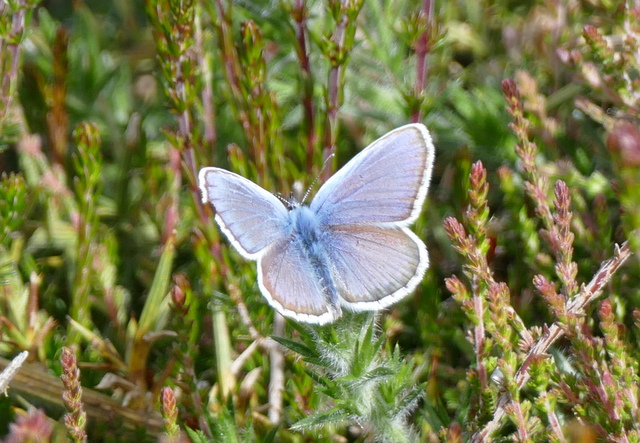 Silver-studded Blue – the first we have seen on the Heath this year
Silver-studded Blue – the first we have seen on the Heath this year
After a good look at the Silver-studded Blue, we went on to look for the Dartford Warbler. Unfortunately, despite the fact that we could hear it calling still while we were watching the butterfly, by this stage it had gone quiet. We had a walk round, but there was no sign of it at first, until finally it started singing again. It was very mobile, zooming off across the Heath, but by following it at discrete distance we were ultimately rewarded with some great views of it perched up on the top of the gorse singing.
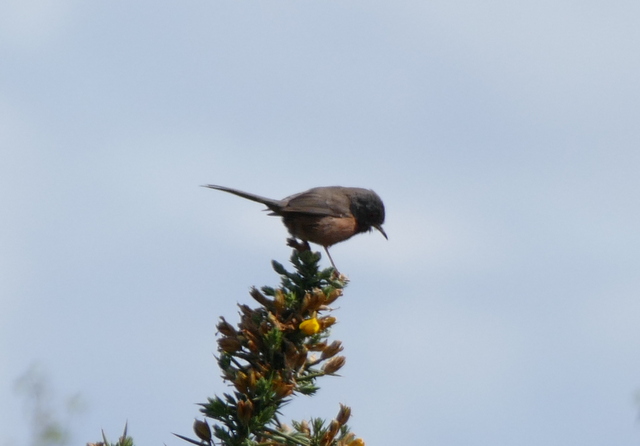 Dartford Warbler – perched on the top of the gorse singing
Dartford Warbler – perched on the top of the gorse singing
We also came across the usual family of Stonechats. The juveniles are much more mobile now, and independent. The male was still feeding around its favoured perches, close to where they nested. While we were watching the Stonechats, we heard a Woodlark calling distantly, but unfortunately it did not appear. It was only as we were walking back that we got a call to say it was feeding along a path further over. We turned back to head over to see it but unfortunately it was flushed by dogs while we were still on our way over, so we reverted to our original plan.
Our next stop was at Cley. Even as we drove along the coast road, we could see a group of large white shapes out on the grazing marsh. We stopped the car and confirmed our suspicions – Spoonbills. And they were doing what Spoonbills like to do most of all – sleeping! We walked out along the East Bank and could see them standing on the bank of the Serpentine. We were only about half way out when a couple of microlight aircraft buzzed overhead and all the Spoonbills woke up. At this point we could see that there were two adults and three juveniles, the latter sporting not yet fully grown spoon-shaped bills. Presumably this was a family party, fresh from the colony. Possibly even the one we had seen departing the other day.
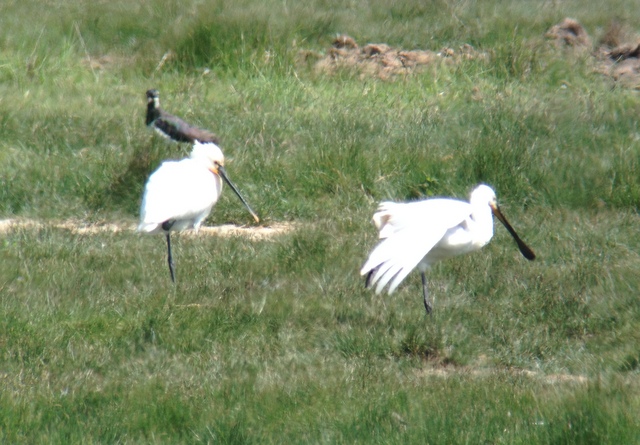 Spoonbills – the birds finally woke up when 2 microlights flew over
Spoonbills – the birds finally woke up when 2 microlights flew over
 Spoonbills – one of the three short-billed juveniles
Spoonbills – one of the three short-billed juveniles
Thankfully, the Spoonbills didn’t fly off when they were disturbed from their slumbers and, once the danger had passed, they went back to doing what they do best. As we got closer, we could see the crests of the adults blowing in the wind, and their duller off-white plumage compared to the juveniles.
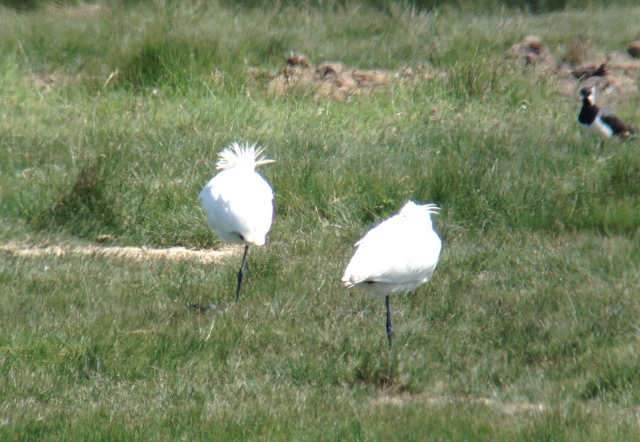 Spoonbills – the adults nuchal crests were blowing around in the wind
Spoonbills – the adults nuchal crests were blowing around in the wind
There was plenty more activity either side of the East Bank. Both Sedge and Reed Warblers were singing, and we got a nice Sedge Warbler in the scope. We could hear Bearded Tits calling at one point but we couldn’t see them – it was a bit breezy out on the East Bank at that stage. However, the Marsh Harriers seemed to enjoy the breeze and we got good views of both male and female circling over the reeds.
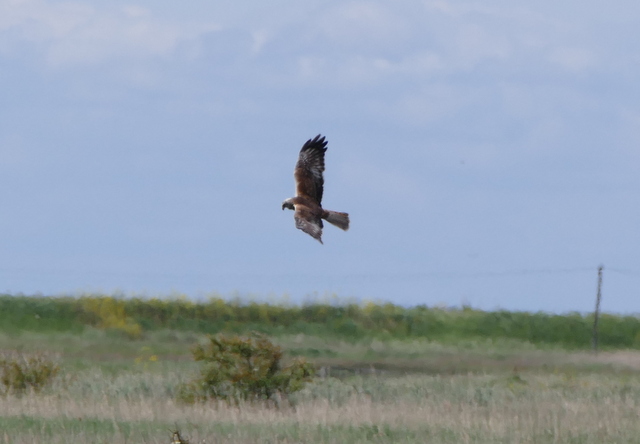 Marsh Harrier – one of the males over the reedbed
Marsh Harrier – one of the males over the reedbed
Out on the grazing marsh, there were lots of Redshanks and Lapwings, the latter particularly chasing anything which came near. The Serpentine also held several Avocets and a pair of Ringed Plovers. A Little Egret was fishing in one of the flooded areas.
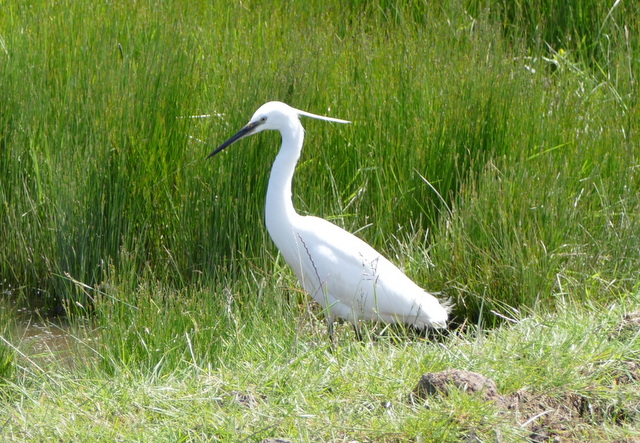 Little Egret – feeding on the flooded grazing marsh, as usual today
Little Egret – feeding on the flooded grazing marsh, as usual today
There was also a good selection of ducks out on the grazing marsh. This included plenty of Gadwall and Mallard as usual. A female Shoveler swam across the Serpentine, flashing her enormous bill. A couple of males were lurking in the grass further back. A single drake Tufted Duck was asleep on the edge of the water. But the biggest surprise in the wildfowl category today was a drake Teal sleeping in the grass – there are not many Teal around at the moment.
While we standing on the bank, a Little Gull flew over in the direction of the reserve – we noted its small size and buoyant flight action. When we got to Arnold’s Marsh, we heard the distinctive call of a Mediterranean Gull and looked up to see two smart adults flying west just behind the beach. Arnold’s Marsh itself held a nice selection of terns – a little cluster of Sandwich Terns, a single Common Tern on one of the islands and a pair of Little Terns. It was a good opportunity to look at the differences between the three of them.
Then it was back to the visitor centre for a late lunch. Even there, the birding didn’t stop. It was a lovely afternoon, so we sat out on one of the picnic tables. Scanning Pat’s Pool, we picked up a Little Gull feeding on the edge of the water, possibly the one we had seen fly over earlier. A Greenshank was preening on the tip of one of the islands. More unexpectedly, a Siskin flew over the car park calling. And we could hear a Cetti’s Warbler singing – loudly – from the bushes down by the road. We got a real treat when it flew up into a hawthorn bush and perched out in full view long enough for us to even get the scope on it!
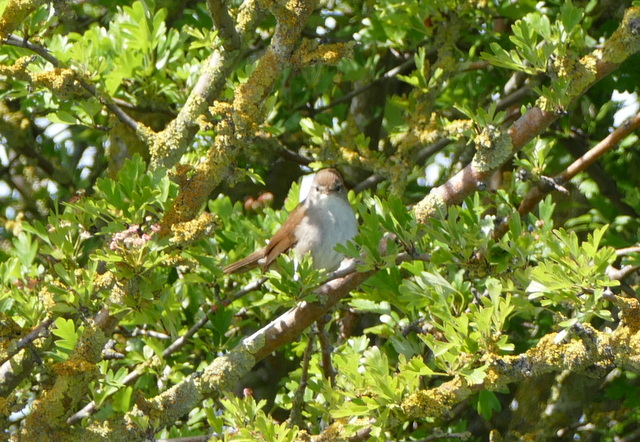 Cetti’s Warbler – serenading us at lunchtime, in its own fashion!
Cetti’s Warbler – serenading us at lunchtime, in its own fashion!
We spent the rest of the afternoon at Holkham. The passerines put on a good show, despite the warmth of the afternoon. A couple of Blackcap sang from the bushes by the end of Lady Anne’s Drive and we saw several more including a family party as we walked west. A mixed-singing Willow Warbler, its song incorporating a passable imitation of Chiffchaff as well as the conventional Willow Warbler bits, was an interesting diversion.
We came across a couple of tit flocks, with their attendant Goldcrests and Treecreepers. One in particular was feeding in some low Holm Oaks by the path and we watched several tits come down to bathe in the ditch, as a Goldcrest flitted about overhead and a Treecreeper preened in the sunshine on a bough.
Out at the Joe Jordan hide, most of the Spoonbills were lurking at the front of the pool today, behind the rushes. We could see them as they preened or flapped their wings, but like the ones we had seen this morning, they also seemed to spend much of the time asleep. Several more birds flew in and out of the colony, or dropped down onto the pool after a busy session out feeding.
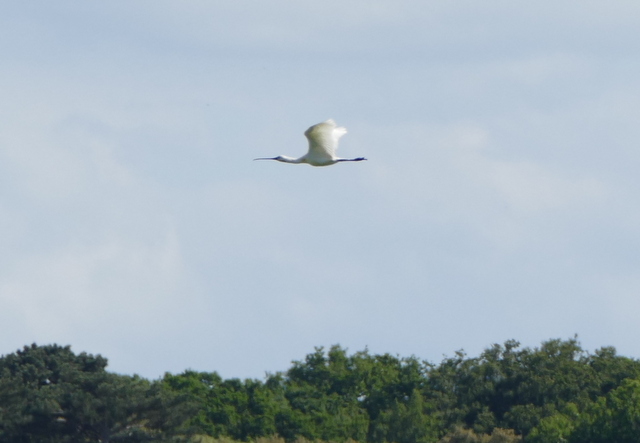 Spoonbill – several birds were coming & going from the colony still today
Spoonbill – several birds were coming & going from the colony still today
As usual, there were Marsh Harriers in the air pretty much all the time we were there. There is a small colony of Black-headed Gulls just to the east of the hide, but they still seem to go up in a panic whenever a Marsh Harrier passes overhead. Today seemingly with good reason, although little effect. At one point we watched a Marsh Harrier fly into the screaming melee of gulls, unconcerned. It swooped down into the middle of the colony and came up with a gull chick in its talons, presumably destined for its own hungry brood.
The grazing marshes are packed with feral geese – mostly Greylags, many with large broods of goslings, but also several pairs of Egyptian Geese. Out in the grass on its own today was a single Pink-footed Goose. During the winter, there are many thousands here, but only a handful stay through the summer, mostly sick or injured birds. We also watched a Stoat running around in the grass below the hide. At one point it came upon a brace of hen Pheasants. The closest of the latter pulled herself up to full height, puffed out her feathers and clucked aggressively at the Stoat until it thought better of attempting that challenge and scurried off.
We had a quick look in on the beach on the way back. It was looking beautiful as ever, and not too busy on an admittedly sunny Monday in school termtime. A little group of four Gannets passed by just offshore. Several Little Terns were feeding just offshore or flying around the beach.
There were a lot of Red Admirals along the path – seemingly one every few metres. Painted Ladys were also much in evidence again today, both at Holkham and at Kelling Heath earlier. As we walked back to the car, a Broad-bordered Bee Hawkmoth zoomed past us and paused to hover in front of some Honeysuckle flowers.
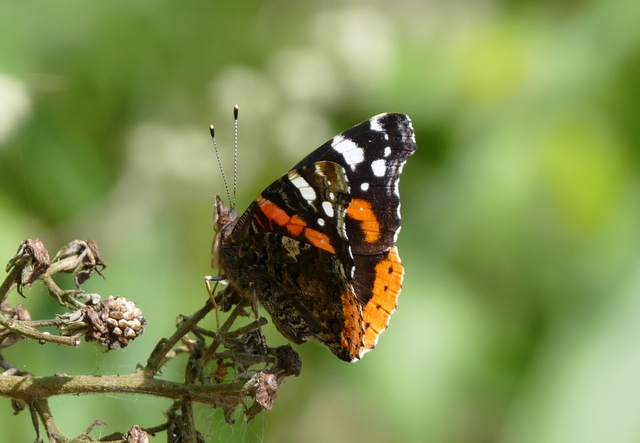 Red Admiral – many more on the wing today
Red Admiral – many more on the wing today
Then it was time to call it a day and head for home.
















